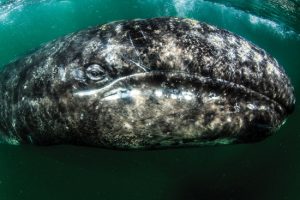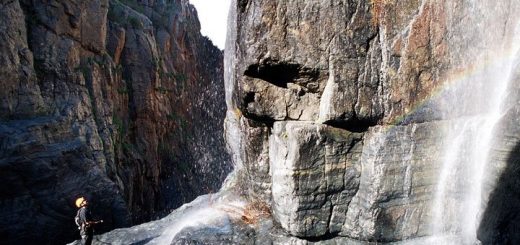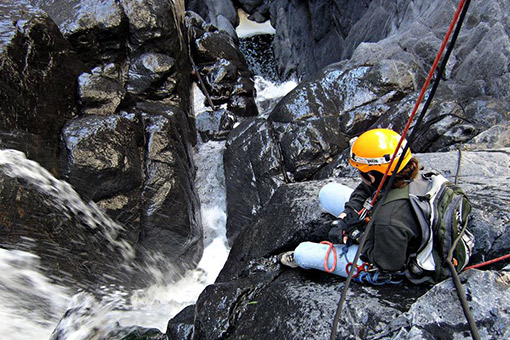Whale watching in Baja
¿Where can we spot whales in Baja?
I started this adventure in Cabo San Lucas, in the famous arch that marks the beginning or end of the Baja California Peninsula where the humpback whales (Megaptera novaeangliae) meet. It is one of the largest whales; Adults have a length of 13 to 14 meters and weigh approximately 36 tonnes (in the Antarctic one recorded 18 meters). They are great travelers: during the summer they feed in polar waters and during the winter they mate and have their offspring in tropical and subtropical waters. They are characterized by their extraordinarily long pectoral fins, by their spectacular acrobatic jumps in which they get to completely remove the body out of the water and by the singing of the males that emit bass and treble sounds in complex sequences. During the time of reproduction, they make more jumps and songs. These whales are the most dynamic and provide a great show for photographers.
It was my job to catch a male that inflated part of the throat and mouth on the surface; is its believed to be to show a larger size compared to competing males. Another image that I obtained was that of a male whipping with the caudal fin on the surface of the sea. Sighting area: Pacific Ocean, Sea of Cortez, Bay of Peace and Loreto Bay.
Season: Winter and spring.
PUERTO ADOLFO LÓPEZ MATEOS
From Cabo San Lucas I moved to Puerto Adolfo López Mateos, to Magdalena Bay, the largest of the Peninsula. Here you can see gray whales (Eschrichtius robustus). In Puerto Adolfo López Mateos there are several cooperatives in the main wharf that offer observation trips and tours of the mangroves and Magdalena Island. Here I observed the first specimens that reached the mouth at the beginning of January. It was a great experience to see them entering the warm waters of Bahia Magdalena after completing the 9 thousand-kilometer journey in three months.  The whales were very calm and during the sunset, they stayed around the boat, where I had the opportunity to photograph them with the sunset; one of them was so close that when I breathed the breeze, I wet the lens of my camera. Sighting area: Puerto Adolfo López Mateos and Puerto San Carlos, in Bahía Magdalena.
The whales were very calm and during the sunset, they stayed around the boat, where I had the opportunity to photograph them with the sunset; one of them was so close that when I breathed the breeze, I wet the lens of my camera. Sighting area: Puerto Adolfo López Mateos and Puerto San Carlos, in Bahía Magdalena.
Season: January to March.
RESERVE OF THE BIOSPHERE EL VIZCAÍNO
I followed the migration and made my way to Mulege, the largest biosphere reserve in Mexico. In the marine lagoons and on the coast of the reserve, 66 percent of the species of marine mammals of the country, including three of seals, eight of dolphins and 15 of whales, including gray, are included. In Laguna de San Ignacio I visited the Baja Expeditions camp. I was invited by my good friend Tim Means, who told me in his choppy Spanish: “See you at the track of San Ignacio”, were all indications. In San Ignacio, I admired the mission founded by the Jesuit Fernando Consag in 1733. I followed a dirt road entering the desolate Desert of El Vizcaíno.
The path was lost between the mirages of the horizon and the lagoons of salitrales of fantastic red and other colors. I finally got to the airport. There I found Tim, a legend in the Low: he knows all its corners and is an important figure in the conservation of nature. The plane landed and American tourists descended as if they were coming to Mars, from San Diego they moved to Tijuana and from there to the heart of the Desert of El Vizcaíno, with a smile they boarded the school truck whose interior is graffiti hippie style with paintings of whales.
We moved to the 100% Ecological Baja Expedition camp, where we received guides José Sánchez and Deborah Röösli, along with the rest of the team, gave us directions and assigned us to our safari-style tents with comfortable cots. In this trip of five days and four nights two daily departures are made to see whales: one in the morning and one in the afternoon and, during the rest of the day, there are walks, marine kayak tours, and observation outings birds, exploring the labyrinth of mangrove reserve. This trip offers the unique experience of being able to share numerous boat trips to see whales, during our meetings we could observe how they played, jumped and how the mother looked after and raised her whale.
IN LORETO
The blue whale (Balaenoptera muscuslus), also known as giant whale, inhabits all the oceans of the planet. In Mexico in the last census, about 300 blue whales have been counted, entering the Gulf of California to feed, breed and breed their whales. I left the Pacific Ocean to go to the Sea of Cortez in search of the largest animal in the world: the blue whale, which reaches 30 meters in length and weighs 190 tons. On this trip aboard the Baja Expeditions catamaran, El Mechudo and for five days we crossed the islands of the marine park and sail to La Paz.
During the trip we made several departures in panga to look for the blue whales, which were very close to Loreto. On our first departure we leave at dawn. Our first surprise was to find a group of mobulas jumping out of the water: they were hundreds and passed under our boat. Immediately I went into the water with the underwater camera to capture some images. We continued with our excursion, when a great spot of dolphins surprised us at dawn, we had not been sailing for an hour and we had already seen blankets, dolphins, humpback whales jumping on the horizon and, very close to them, the boatman, with his trained eye, pointed us to the tail of a blue whale.
We approach with the binoculars. The blue whale goes out to breathe between eight and fifteen times and then submerges for periods of three to twenty minutes; they can dive up to 150 meters deep and, generally, before dipping they take out their caudal fin. During our waiting we were suddenly surprised by a great snort: the blue whale came out right in front of the boat! We were literally out of breath. It is one of the most beautiful experiences that nature can offer.
Being face to face with the world’s largest animal in the seas of our country is a great gift. He came out to snort in front of the panga and I could photograph it: he could see himself passing and passing, I captured his grayish-blueish silhouette beneath the surface and, finally, I shed his tail and submerged. Sighting Zone: In Mexico we find it on the western coast of the Baja California Peninsula and the Sea of Cortez; specifically, in the Bay of Loreto National Park. Season: From November to May.
The blue whale goes out to breathe between eight and fifteen times and then submerges for periods of three to twenty minutes; they can dive up to 150 meters deep and, generally, before dipping they take out their caudal fin. During our waiting we were suddenly surprised by a great snort: the blue whale came out right in front of the boat! We were literally out of breath. It is one of the most beautiful experiences that nature can offer.
Being face to face with the world’s largest animal in the seas of our country is a great gift. He came out to snort in front of the panga and I could photograph it: he could see himself passing and passing, I captured his grayish-blueish silhouette beneath the surface and, finally, I shed his tail and submerged. Sighting Zone: In Mexico we find it on the western coast of the Baja California Peninsula and the Sea of Cortez; specifically, in the Bay of Loreto National Park. Season: From November to May.
He came out to snort in front of the panga and I could photograph it: he could see himself passing and passing, I captured his grayish-blueish silhouette beneath the surface and, finally, I shed his tail and submerged. Sighting Zone: In Mexico we find it on the western coast of the Baja California Peninsula and the Sea of Cortez; specifically, in the Bay of Loreto National Park.



